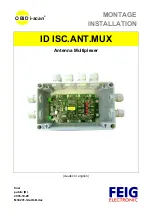
RESISTANCE MEASUREMENTS
1.
Connect RED lead to
“V
Ω
Ω
Ω
Ω
Ω
mA”
input socket and the
BLACK lead to COM.
2.
Set range selector switch to desired
W
position.
3.
IMPORTANT
: If the resistance to be measured is
connected to a circuit, turn OFF the power and
discharge ALL capacitors before applying the test prods.
4.
Connect the test leads and read resistance value on
the digital display
hFE MEASUREMENT
1.
Insert E, B and C pins of transistor to the corresponding
slots in the hFE socket, paying special attention as to its
type - NPN or PNP.
2.
Read the hFE value on the digital display.
DIODE TESTING
1.
Connect RED test lead to
“V
Ω
Ω
Ω
Ω
Ω
mA”
input socket and
BLACK to COM
2.
Set the rotary switch to the
position.
3.
Connect the RED test leads to the anode of the diode
and the BLACK lead to the cathode.
4.
The approx. forward voltage drop will be displayed on
the LCD in mV. It the polarity is reversed, Fig. “1” will be
displayed.
BATTERY AND FUSE REPLACEMENT
CAUTION
Before opening the back cover, ensure the test leads are
disconnected from any energised circuits to avoid the
possibility of electric shock
.
It “BAT” appears on the LCD, this indicates that the battery
needs replacing. The fuse should rarely need replacement,
and a blown fuse is almost always as a result of operator error.
1.
Remove the two phillips screws from the back of the
unit, and carefully withdraw the back cover.
2.
Carefully pull out the blown fuse and replace with one
of the same value - 0.8Amp 250V Fast Blow.
3.
Replace the battery with one of the same value- 9V
alkaline or carbon-zinc battery (NEDA16O4), being
careful to observe polarity
SAFETY SYMBOLS
This marking adjacent to another
marking or terminal or operating
device indicates that the
operator must refer to an
explanation in the Operating
Instructions to avoid damage to
the equipment and/or to avoid
personal injury.
This war ning sign denotes a
hazard, It calls attention to a
procedure, practice or the like,
which, it not correctly performed
or adhered to, could result in
personal injury.
This marking advises the user that
the terminals so marked must not
be connected to a circuit point
at which the voltage, with
respect to earth ground,
exceeds, in this case, 600V.
This symbol adjacent to one or
more terminals, identifies them as
being associated with ranges
that may, in nor mal use, be
subjected to particularly
hazardous voltages. For
maximum safety, the instrument
and the test leads should not be
handled when these terminals
are energised.
This symbol indicates that the
instrument complies with all
requirements for double
insulation.
For Spare Parts and Servicing, please contact your nearest dealer, for
CLARKE International on the following number:
020 8988 7400
WARNING
600Vmax
SAFETY PRECAUTIONS
1
To avoid electrical shock and/or damage to the instrument,
do not measure voltages that exceed 600V above ground.
2. Before use, ALWAYS inspect the test leads, connectors and
prods for cracks, breaks or crazes in the insulation. If in doubt
do not use. Renew the parts as necessary.
3. Never exceed the protection limit indicated in the
specifications for each range of measurement.
4. Never perform resistance measurements on live circuits.
5. Before inserting transistors for testing, ensure that test leads
have been disconnected from any measurement circuits.
DC VOLTAGE MEASUREMENT
1. Connect RED test lead to
“V
Ω
Ω
Ω
Ω
Ω
mA”
socket and BLACK to COM
2. Set range selector switch to desired DC V position. If the value
to be measured is unknown, set the selector to the
highest range, and reduce until satisfactory reading is realised.
3. Connect test leads to device or circuit to be measured.
4. Turn power, to device being measured-ON. The voltage value
will be displayed on the digital display along with the polarity.
DC CURRENT MEASUREMENT
1. Connect RED lead to
“V
Ω
Ω
Ω
Ω
Ω
mA”
input socket for measurements
up to 200mAmps, and the BLACK lead to COM.
For measurements between 200mA and 10 Amps, connect
RED lead to 10A input socket ensuring it is fully depressed.
2. Set range selector switch to desired DC A position.
3. Open the circuit to be measured and turn ON the power.
4. Connect the leads across the load, i.e. in series with the
load to be measured.
5. Read the current value on the digital display.
AC VOLTAGE MEASUREMENTS
1. Connect RED lead to
“V
e
e
e
e
e
mA”
socket and BLACK lead to COM.
2. Set range selector switch to desired AC A position.
3. Connect test leads to device or circuit to be measured.
4. Turn power, to device being measured -ON. The voltage value
will be displayed on the digital display along with the polarity.
DIGITAL MULTIMETER
Model No: CDM10A
Part Nio: 45800005
Operating Instructions
Before using this instrument, you should read and
fully understand this instruction leaflet.
Failure to understand and comply with the
warnings and operating instructions can result in
serious or even fatal injury and/or damage to
property.
0507




















